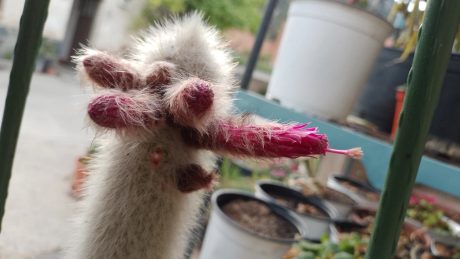Today, I present you with a cactus that I am particularly keen to explain to you, because it’s one of the examples that I had first at home and is one of the first to acquire when I started collecting it, and I have had it for ten years. It is the Cleistocactus Strausii, commonly called the silver torch. It is from Argentina and specializes in mountainous regions. They are columnar cactus that as it grows branching from the base and can reach two meters in height by six centimeters wide if it is planted directly on the ground and likes the soil where it is planted.
It is a curious plant because at the tip it has a white oldness that seems to be nothing below, but let that not fool you, because under these white hairs there are some points that are quite clumsy. The spines arise from the twenty-five ribs that make up the cactus, most of which are hidden are small, but there are between four and six of them larger, yellow and can be seen with the naked eye.
The flowers, I personally have never seen one for the moment (but it has to be said that in the next few days, the same specimen I am describing will give me the opportunity to see it flourish), people who have seen them say they are tubular red flowers. They usually come out in the spring, but some say that they can also do in the fall. Once the flower has marshy, it gives way to green fruits. It needs a direct exposure of sun and a rather dry climate.
They are also very good because they resist frost up to ten degrees negative if the substrate is dry and there is no ambient moisture (or very low). And irrigation must be abundant in summer and null when the cold begins. It is acceptable to irrigate once every fortnight in the spring, once a week in the summer (twice at most if you live in an area where it is very hot) and stop irrigating in the middle of the autumn, if you water just as the autumn begins, you must be clear that this will be the last contribution of water before the winter rest. As always, between irrigation and you must ensure that the substrate is completely dry.
Finally, you cannot access with water or irrigate if the substrate is still pierced because it can be attacked by fungi (they come out if there is excess water) or it can also be attacked by the cottony mealybug.







Reviews
There are no reviews yet.